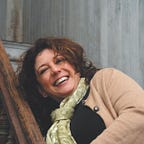What Is Holy?
I used to pass an old stone church that houses an elementary school on my way to work. Every day I saw the children as they entered. Parents kissed their children goodbye. Teachers welcomed the children. A beautiful garden surrounded the school entrance. I often stopped and took pictures of the flowers in the garden. Peonies. Irises. Roses. Pansies. Marigolds. The garden reflected the change of the seasons. I knew the rhythm of this scene. One random day, I noticed a rock that I had never seen. A question was written on the rock, “What is Holy?”
The question stopped me in my tracks.
How many times had I passed it and never noticed? Why did I notice it this morning? Do the children ever read it and wonder? I took a picture of the rock and posed the question on Facebook and Twitter. A few Facebook comments immediately requested and/or offered a response. My high school religion teacher, who is a Facebook friend, suggested that everything might be holy. (Interesting thought.) I had no immediate response. I did not have time to reflect. I had to go to work. I had to observe children playing on a playground around the corner from the church as part of a research project on which I was working, so the question hovered.
There was something beautiful and perfect about the timing of the question.
I switched into program evaluator mode and prepared to note the way three-to-five year old children were interacting with each other and with the nature-based playground. I had gotten to know the children over the many weeks we had spent on the playground. We watched the seasons change together. At first they were curious about what I was doing, but they soon became too busy for my evaluator’s gaze and paid no attention to the person with the note pad and video camera. I learned very quickly the harsh truth that playground interviews were not the way to learn about the meaning children were making from the playground experience. I kept doing interviews, but field notes that captured my observations added to the story. I would quickly write down what I was seeing on the playground amidst the controlled chaos. Simply understood, I was documenting the experiences the children were having in the hope we might better understand the impact of play on informal science learning.
I thought about the holy rock as I recorded field notes.
I was doing my job, and my job felt big. Holy feels big. I took notes and moved around the ground with systematic intensity to make sure I did not miss anything. There was something important to my action and the action of the children. Intentional does not capture it. Focused falls short. Maybe reverence comes close to what I was feeling. I deeply appreciated every moment witnessing children building sand castles, pretending to be puppies, singing songs to one another at the top of their lungs in the middle of a tunnel to hear the echo, or climbing to the top of the tree house to escape tigers.
Holy is everywhere on the playground.
Unbridled laughter. Belly-shaking tears. Ernest conversation where secrets are revealed. Hide-and-seek corners. Playground sounds profess profound intensity that speaks of happiness perched on its tiptoes watching the world in amazement. Joy lives on the playground as friends dance. Sadness and anger hang as friends disagree. Peace emerges as enemies forgive. There is wonder as superheroes fly. Fallen leaves are thrown and we listen to the crack and crinkle of the moment. Pumpkin centers bust and seeds ooze through fingers. Logs becomes fortresses, or houses, or space ships. Really seeing, touching, tasting and hearing is holy. Imaginations are holy. Presence is holy. Creating is holy. I thought I was studying children and science, instead I was learning about the holy in my world.
